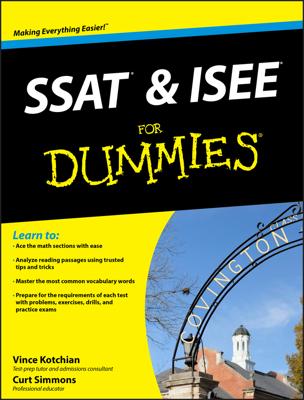English teachers have created a list of common errors that make up the Grammar Hall of Shame. But you won’t be ashamed of your PSAT/NMSQT score if you review these basic grammar concepts.
Agreement
Grammarians love agreement, which is why so many agreement problems appear on the PSAT/NMSQT. This grammar principle matches singular with singular and plural with plural. Specifically, check for agreement in these areas:
Subjects and verbs: You probably know the easy ones (“Matt has a cold,” not “Matt have a cold”), but you may be less sure about the proper verb when the subject and verb are separated by other words. Ignore interrupters such as “as well as,” “in addition to,” and “along with.” These phrases appear to make the subject plural, but they’re just camouflage.
Pronouns and antecedents: Don’t panic. Antecedent is just a fancy term for the word a pronoun refers to, which may be a noun or another pronoun. Most people have little trouble matching a noun with its pronoun (“boys” and “them,” for example).
However, errors pop up with pronoun/pronoun pairs. All these pronouns are singular: everyone, everybody, everything, someone, somebody, something, anyone, anybody, anything, no one, nobody, nothing, either, neither, each, and every. When you refer to one of these pronouns, use his, him, it, or her, not their or them. In other words, “everyone handed in his or her test,” not “their test.”
Case
Case is the grammar term for the difference between I and me and mine. The first is a subject pronoun, the second an object pronoun, and the last a possessive pronoun. Here’s what you need to know about each type:
Subject pronouns may function as the subject of a sentence. Subject pronouns also show up after verbs that express a state of being, but don’t worry about those situations; the PSAT/NMSQT doesn’t throw those sentences at you. Subject pronouns include I, you, he, she, it, we, they, whoever, and who.
Object pronouns function as objects. Grammarians aren’t terribly original in their terminology, right? You need object pronouns after verbs, verbals (words that resemble verbs but act as nouns or descriptions in a sentence), and prepositions (words that express relationships, such as by, for, from, to, about, on, and so forth). Object pronouns include the following: me, you, him, her, it, us, them, whomever, and whom.
Possessive pronouns express ownership. Possessive pronouns include my, mine, yours, his, her, hers, its, our, ours, their, theirs, and whose. Possessive pronouns don’t need apostrophes to show ownership, and the test-makers may check to see that you understand the difference between whose (possessive) and who’s (a contraction of “who is”).
Verb tense
English has six tenses, but most cause little difficulty. On the PSAT/NMSQT, three verb tense situations may stump you:
Present perfect tense: This tense uses has or have with another verb (has fallen, have written, has been, and so on). Present perfect tense links the past and present. If someone tells you, “I have lived there for 89 years,” it means she is still living there, and she lived there in the past also.
The simple past tense (“I lived there for 89 years”) implies that she lives somewhere else now.
Past perfect tense: Tack a had onto another verb and you’ve got past perfect tense, which moves an event in the past to a point that is earlier than another past-tense event. For example, “Judy had bubbled in three answers before the proctor threw her out.” The bubbling occurred before the throwing out.
Unnecessary shifts: You may run across a sentence that begins in one tense and then shifts to another. If you need to show a change, fine: “Yesterday Henry was tired, but tomorrow he will be full of energy.”
In this example, the verb was is past tense because that part of the sentence discusses yesterday; the verb will be is in future tense, which is appropriate for the part of the sentence discussing tomorrow.
Complete sentences
English teachers hate run-ons (two sentences improperly run together) and fragments (a bunch of words that don’t add up to a complete sentence). What’s a complete sentence? Look for a subject/verb pair and a complete thought. Check out these examples of a complete sentence, a fragment, and a run-on:
Complete sentence: Daisy cried with joy after receiving a high test score. (The subject/verb pair is “Daisy cried.” The sentence expresses a complete thought.)
Fragment: Having studied so much, Daisy, screaming about her high scores. (This statement lacks a subject/verb pair. One possible correction: Having studied so much, Daisy screamed about her high scores.)
Run-on: Daisy ran to show her scores to Uncle Oscar, he had promised her a reward. (Each half of this statement is a complete sentence, but only a comma joins the two parts. Penalty box! Use a semicolon or add because before the second statement.)
Parallelism
Proper English values balance, so if you see a list or paired conjunctions (either/or, neither/nor, or not only/but also, for example), check for parallelism. The rule is simple: Everything performing the same job in the sentence must have the same grammatical identity. Check out these incorrect and correct examples:
Incorrect: Bob wants to go shopping, to buy a new For Dummies book, and having fun reading it. (The last item on the list doesn’t match.)
Correct: Bob wants to go shopping, to buy a new For Dummies book, and to have fun reading it. (Now everything matches.)
Incorrect: Bob will either ace the PSAT or he will pay his sister to take the test. (Forget about grammar for a moment. Don’t even think about cheating! Okay, back to grammar. After the first conjunction, “either,” you have a verb (“ace”), but not a subject. After the second conjunction, “or,” you have a subject (“he”) and a verb (“will pay”). Not parallel!
Correct: Bob will either ace the PSAT or pay his sister to take the test. (Now both conjunctions are followed by verbs, “ace” and “pay.”)

